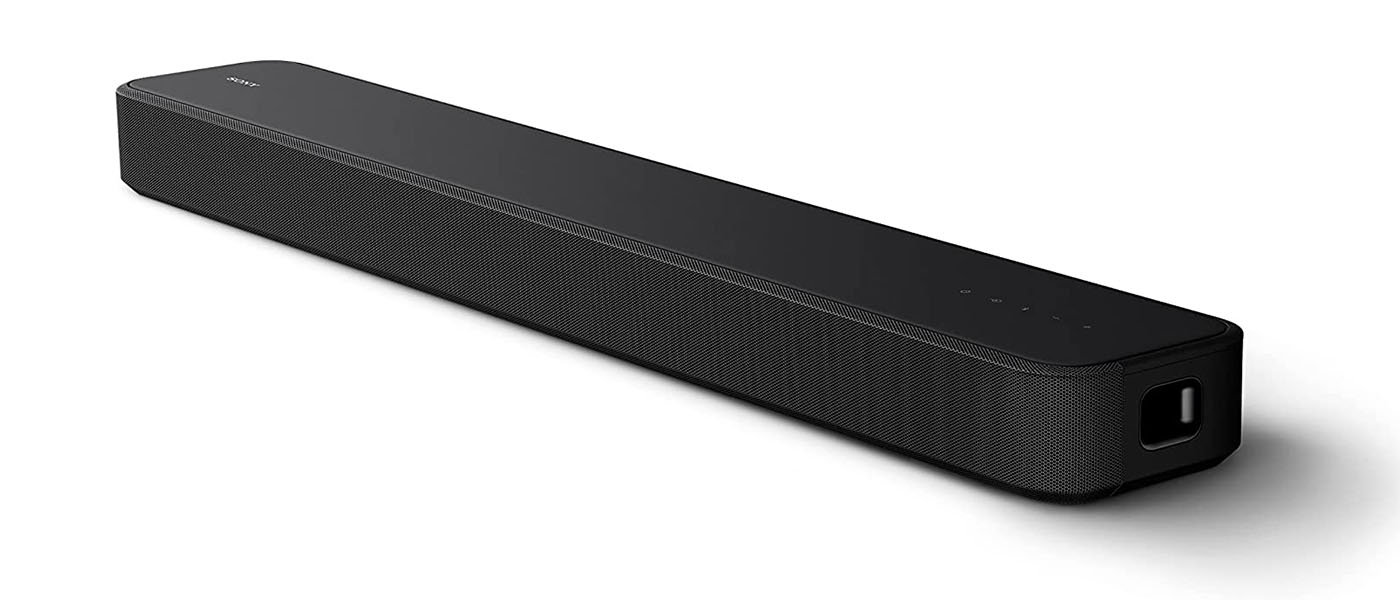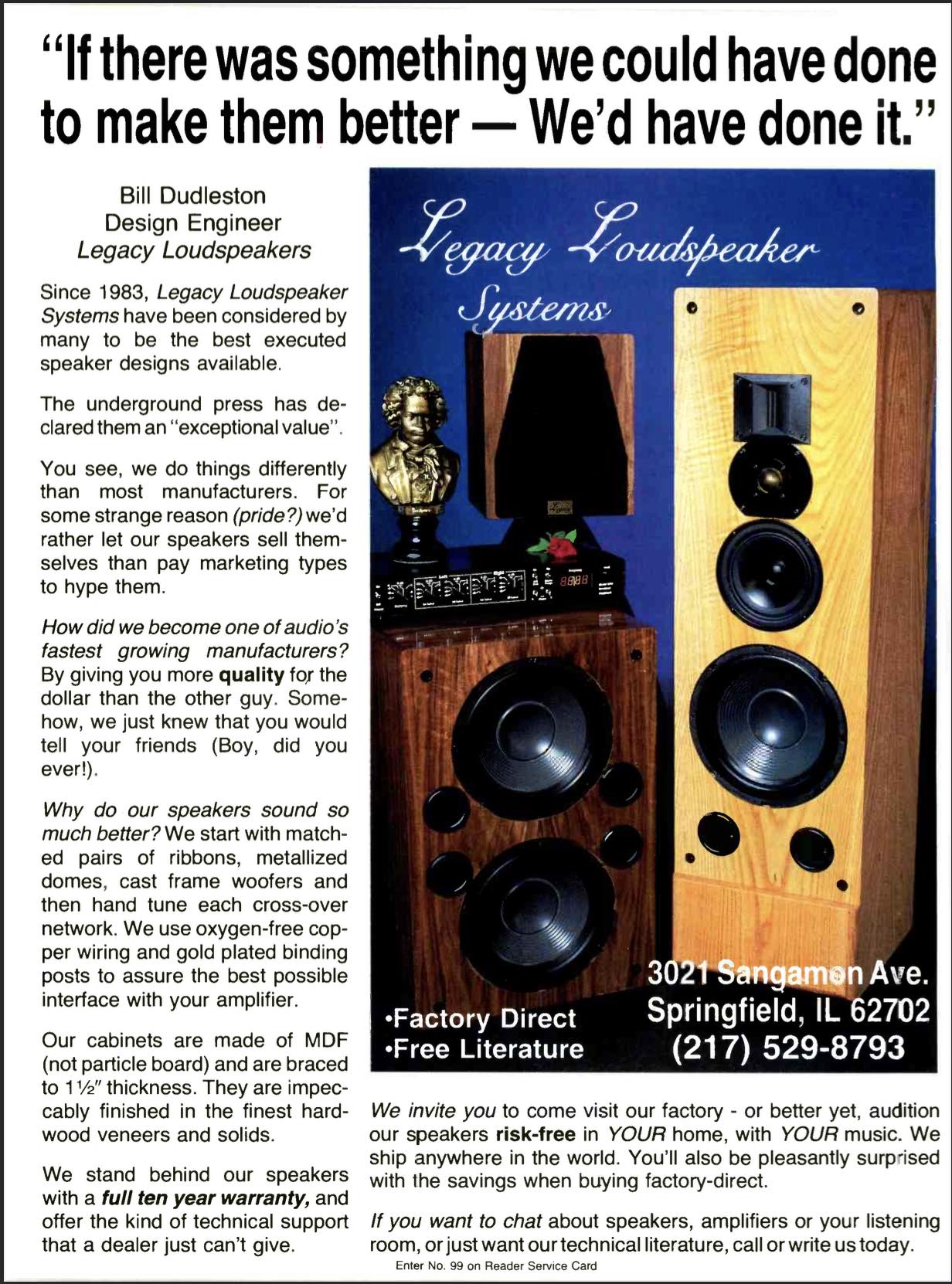
The year was 1988, and at the age of 28, I was looking for a pair of high-end audio speakers for under $2,000 per pair (about $5,000 in today’s currency). A relatively young company called Legacy Audio had speakers called the Model 1. Their ad in Audio magazine showed a 100-pound tower speaker designed by a gentleman named Bill Dudleston. He talked about premium components, ribbon-leaf tweeters, built-in subwoofers, and incredible performance. He was also selling factory direct, which meant buying without listening. After three phone calls, I mailed him a check. Mailing checks was a common practice back then. The Model 1s were speakers that thrilled me for over a decade, only to be damaged by movers in 1999.
Over the years, they have been the one speaker out of dozens that stands apart in their ability to bring out all the music. Three and a half decades later, the opportunity came up to review the Focus XD. My listening room in 1988 was about 1,800 cubic feet, and my current room is about 4,000 cubic feet. The relative room size to cone area on the two speakers was commensurate. Can this Focus XD bring this magic back into a room over twice the size? It is time to let the games begin!
Legacy Audio Focus XD Floor Standing Speaker Highlights
- Elegant Styling.
- Choice of furniture quality wood finishes.
- Custom-built and fine-tuned by the engineer who designed it.
- Internal amp can drive speaker full range – just add a source and pre-amp.
- Internal amp can drive integrated subwoofer for those who want to use a dedicated amp for mids and highs.
- Dedicated dual 7-inch mid-woofers.
- Built-in powered 12-inch subwoofers.
- Dual Air Motion Tweeters in a single plate.
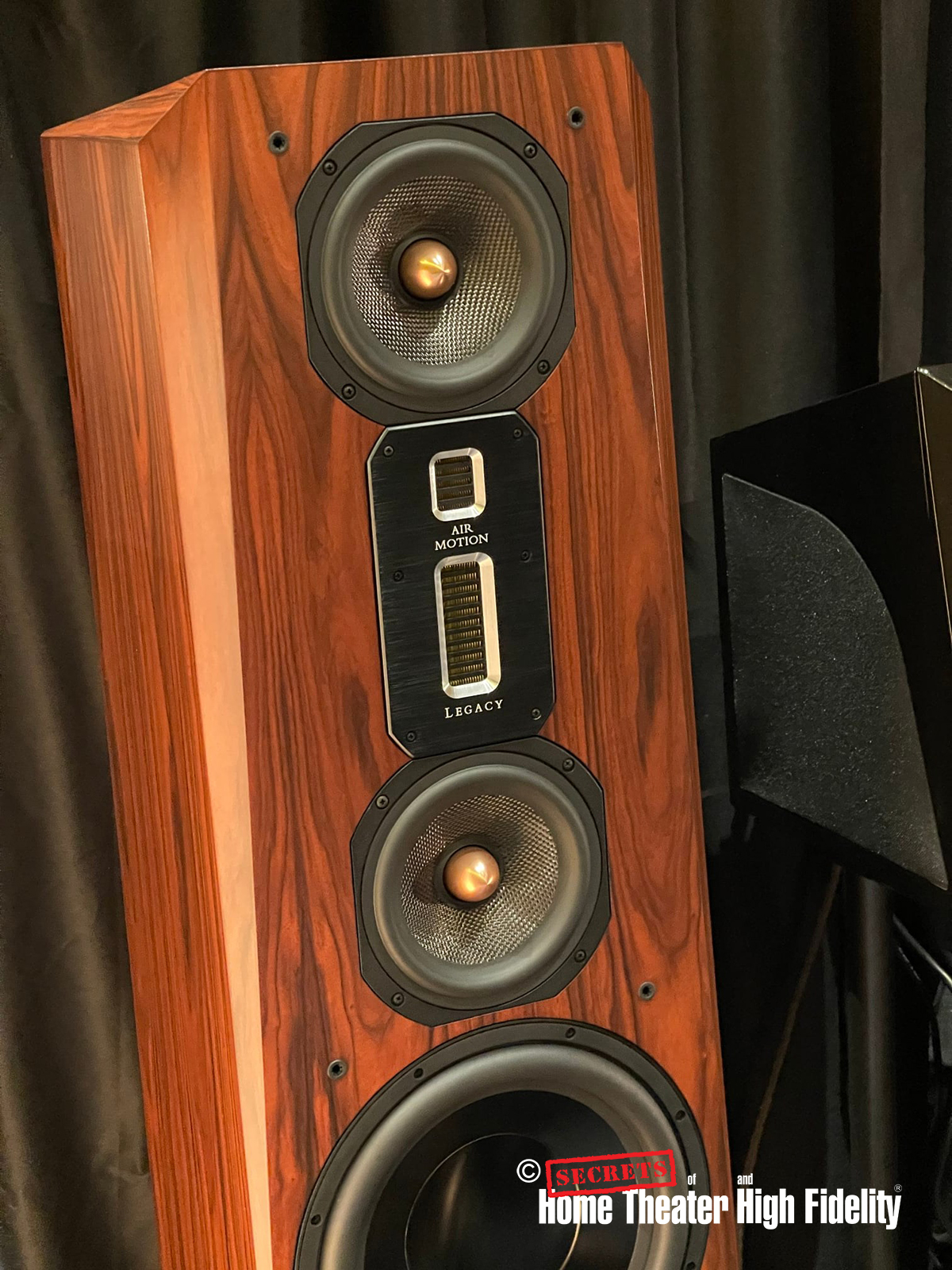
Below is a brief look at the options that Legacy builds into the Focus XD and its internal amp:
- The new FOCUS XD version includes a high-quality internal 750-watt amplifier which provides some unique performance options.
- Use the internal ICE power amp with its 30-amp peak current capability to drive the entire speaker full range via the passive internal crossover. The Focus XD is a fully powered loudspeaker at this point and can be controlled with a pre-amp or DAC with a volume control.
- Allocate the internal amp’s 750 watts entirely to the bass section to power the lower 12” woofers of Focus XD, while driving the upper section with your external amplifier. This method of passive bi-amplification minimizes current demands from the upper-range amplifier and reduces the presence of back EMF from the woofers. Your amplifier will work less hard, and the speaker will sound more effortless.
- Utilize an external crossover. This will link the woofers directly to the internal amp, eliminating the passive crossover from the path.
The Focus XD can be viewed as a melding together an ultra-high-end two-channel monitor featuring dual seven-inch mid-woofers that cover the all-important bandwidth from 120 to 2,800Hz plus a 4-inch and 1-inch Air Motion Tweeter. Combine that with a powered dual 12-inch subwoofer package, each with its own dedicated 750-watt ICE amp into one speaker that brings all the advantages of a separate subwoofer/speaker package in one elegant tower. There is no need to balance the subwoofer with the other drivers, as it is built in. One can also run the speakers full range from the included amp (popular with studios who use the Focus XD as monitors) and true bi-amping with the appropriate external crossover. Legacy offers its own dedicated pre-amp/DAC/crossover in the form of the Wavelet II – which will be the impetus for the ‘Part II’ of this review.
Most users will opt, at least in the beginning, to run the Focus XD in a passive bi-amp mode with the internal amps driving the subwoofers and a dedicated power amp driving the dual 7’s plus the tweeters, and that is what we did for this review.
Application:
Configurable, internally powered full range or bi-amp capable tower with mastering grade clarity
System Type:
6-driver, 4-way Tower System with Built-in Powered Subwoofers
Tweeter:
Dual Air Motion Tweeter System- 1″ AMT Super Tweeter, Kimber silver HF wire
Midrange:
Dual Air Motion Tweeter System- 4″ AMT Tweeter
Mid-woofer:
Dual 7″ Graphene-filled carbon fiber cone with cast frame
Subwoofer:
Dual 12″ ultra-linear bass drivers with 15lb motor
Low-Frequency Alignment:
Assisted 6th order Butterworth, dual rear ported
Inputs:
1 Pair binding posts for upper range, 1 XLR balanced for full range or bass section
Internal Amplification:
750-Watt ICEpower amplifier
Recommended Amplification:
1 channel of 10 watts minimum for bi-amping upper range
Freq. Response (Hz, +/-2dB):
18-30kHz
Impedance:
4 Ohm/ 10k amp Input
Sensitivity:
95.4 dB (2.83V@1m)
Crossover (Hz):
120, 2.8K, 8K
Cabinet Dimensions H x W x D (inches):
55 x 14 x 15.375
Weight:
141 Ibs.
Shipping Weight:
193 lbs
MSRP:
$15,200 per pair to $17,590 per pair depending on the finish
Website:
Company:
SECRETS Tags:
loudspeakers, legacy audio loudspeakers, legacy audio reviews, legacy audio loudspeakers review
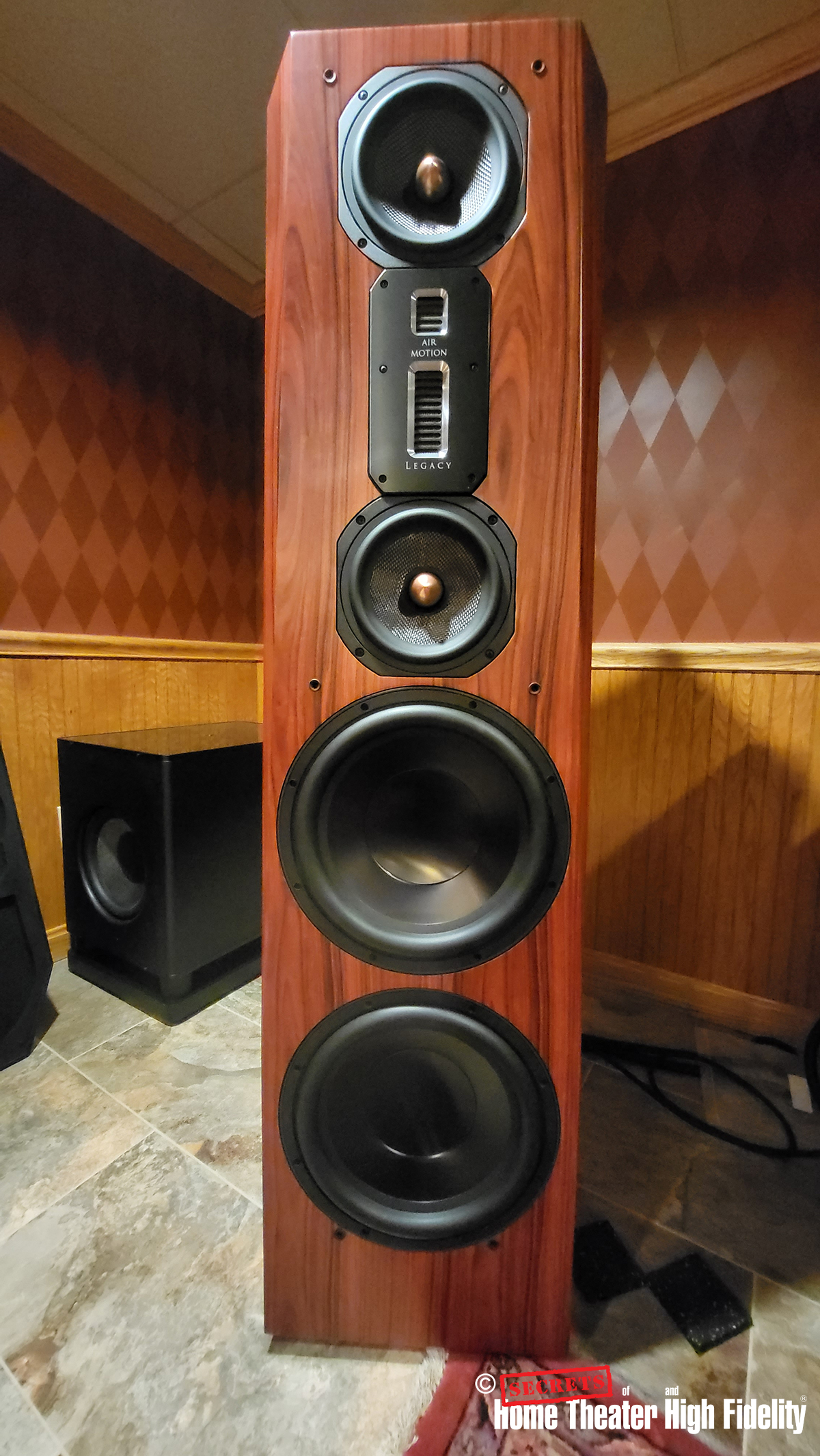
Bill Dudelston takes a great deal of pride in his speakers. Most are built to order. (I ordered mine in a pair of Rosewood-finished cabinets that were already built to ensure no special treatment was given to the review speakers). Directly from the website, here is the promise one gets when ordering a pair of Legacy speakers:
“Legacy’s tuning and testing process is very meticulous and involves pair matching each pair of loudspeakers. We hand-tune the crossovers of each and every pair of speakers to a “master curve”, which is the target function we try to achieve. Each loudspeaker is first individually tested to the master curve. Once we’ve done that, we then look at the deviation of each loudspeaker from the master curve and how they relate to each other with the two speakers equidistant from the microphone…. Adjustments are then made until the two loudspeakers are as close as possible to the target response. Next, we invert the polarity at one of the speaker inputs to test the summation null (quality of cancellation). Final adjustments are made to the pair until one speaker nearly cancels the other.”
There is even more detail available on Legacy’s website, and this protocol is how the company ensures that each speaker pair is built to be “within 0.25 dB” from left to right speaker across the bandwidth.
The speakers are constructed of 1.25-inch MDF and covered with a veneer that is so well done that it looks like solid wood. This type of craftsmanship requires a lot of both talent and time. The 55-inch-tall towers are imposing in appearance yet were met with enthusiasm by my decorator wife. She declared them to be gorgeous.

From bottom to top, we have the dual 12-inch subwoofers with 15-pound magnets, the first 7-inch mid-woofer, the 4- and 1-inch Air Motion tweeters, and the second 7-inch mid-woofer. The rear panel has the ports, the amp controls, and the speaker inputs. The speaker’s front has a narrowing bevel that adds a degree of elegance to the design.
The two tweeters are mounted in the same faceplate and act as a cohesive unit, with the larger 4-inch unit’s exceptionally powerful neodymium magnets affording the ability to deliver lower treble with more authority than is typically available in ribbon or dome tweeters.
Secrets Sponsor
The 7-inch mid-woofers are of exceptional strength combined with a lightweight Graphene-filled carbon fiber cone that is the cornerstone of the high efficiency and output of the Focus XD with the promise of exceptionally low distortion. These woofers and the tweeters have as little mass as possible in order to speed up the ability of the speakers to convert the electrical signal to sound waves to a degree most speakers cannot manage.
An often-overlooked aspect of any speaker design is the SPL available with a 2.83-volt input. The typical floor-standing speaker has about 88-89 dB in SPL at one meter for this 2.83-volt signal. Legacy delivers 95.4dB (one meter / 2.83 Volts) sensitivity with the Focus XD. Compared to most speakers in its size and price class, this is 6dB more efficient in terms of converting wattage to SPL. This means a Focus XD will deliver the same SPL with 25 watts that most will with 100 watts. In theory, this should also lead to lower distortion at higher SPLs than with most speakers.
A note about the design of the Focus XD: The subwoofer section does not allow for any volume adjustments other than the master volume of one’s pre-amp or pre-amp/processor. Products such as the Legacy Wavelet 2 or most higher-end home theater pre-amp/processors allow for adjusting the subwoofer section. For those who are using a dedicated 2-channel pre-amp with XLR outputs that don’t allow for a separate volume control of the subwoofer level in each speaker, Legacy offers a $100 fix.
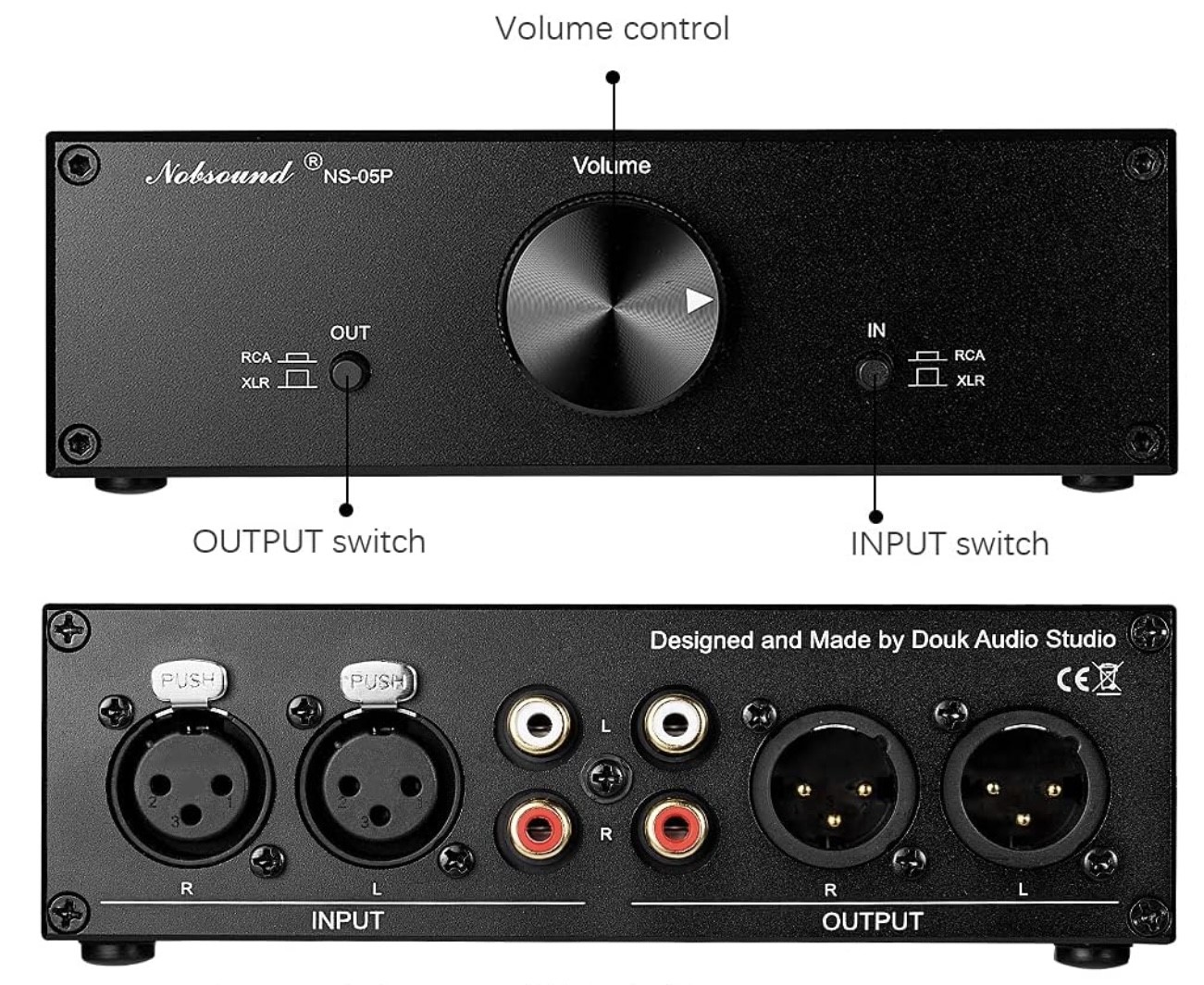


Secrets Sponsor
The speakers are about 12 feet apart and 13 feet from the listening position with roughly a 10-degree toe-in. The backs of the speakers are 30 inches from the back wall.
For cables, the first half of this review was with the standard power cords supplied with each component along with Better Cables XLR interconnects and Blue Jeans Cables 10-gauge speaker wire. About halfway through the review process, Clarus Cables offered up a complete system of two power conditioners, speaker cables, XLR interconnects, and power cables. These components will get a paragraph or two as an addendum in this review, with a full review pending later in the fall of 2023.
The speakers were then subjected to a 200-hour burn-in period using the sine wave sweep from Dayton Audio’s Omnimic test disc before we did any listening.

Dire Straits “Brothers In Arms”
‘Brothers In Arms’ is an SACD descended from the original CD that I purchased in the mid-80s. It was one of the go-to discs I used back then to show off speakers I owned, including those previously mentioned Legacy Model 1s. ‘So Far Away From Me’ opens with Knopfler’s vocals hitting all the right spots and that deep kick drum being deeper than I remember. It’s a great warm-up to the band’s all-time anthem song, ‘Money for Nothing.’ Almost anyone who owns this album or CD knows that ‘Money’ needs to be cranked up (this one goes to 11) to the point of challenging one’s speakers. The Legacies are so capable of high output that I didn’t push that far, but we were still rocking the house and being treated to a far more palpable presence of both Knopfler’s vocals and Sting’s cameo appearance than I have yet to experience.

Various “Extended Dynamic Experience 4”
(This disc was auditioned with the Clarus Cables/Conditioners in the system)
This wonderful disc is considered by many to be the most dynamic CD STS Digital has ever produced, with the help of the unique STS Digital MW Coding Process. It was developed to challenge the ability of any loudspeaker pair (and associated equipment) to deliver every possible musical instrument, and any shortcomings of a speaker will quickly be revealed.
Yella’s ‘Rubberbandman’ is up next – which treats us to percussion with a bass line much higher in frequency than the one in ‘Hippo.’ The baritone voice is handled with authority, and the overall clarity is nothing short of astonishing. The sound I was hearing from this system reminded me a lot of the type of full range, distortion-free, deep soundstage performance from some $300,000-$400,000 systems I have auditioned at ultra high-end audio dealerships. It’s the type of sound one never forgets, and it makes one understand why those who can afford such a system are happy to shell out that type of cash.
Dede Priest is up next with ‘Blues Wine,’ and her silky voice shows off the power handling ability of the 4 x 1 inch Air Motion tweeter. Most speakers will lack a bit in making her sound natural if one is listening at a level one would expect at a proper venue concert, but the Focus sailed through this as would a speaker with a much higher price tag.
The percussion and stand-up bass in ‘Night Train’ by Christian McBride continues the thrill ride that these speakers can deliver. When the body of the bass is hit during the more powerful notes, it comes through with such natural ease that one stops thinking about speakers and starts thinking about the music.
Each track on this disc brings a new challenge to any system. Typically, when auditioning a pair of speakers with Extended Dynamic Experience 4, I listen to the first minute or two of each track, get a feel for it, and move along. With the Focus XD, I didn’t want any track to end. Marcus Miller’s ‘Power’ is a combination (at least to this reviewer) of jazz fusion and hard rock. The bass and drum work requires excellent macro dynamics, and the big towers just smile and keep on rocking the house. One could almost finish an entire review with this disc alone but read on for more challenges for the Legacies.
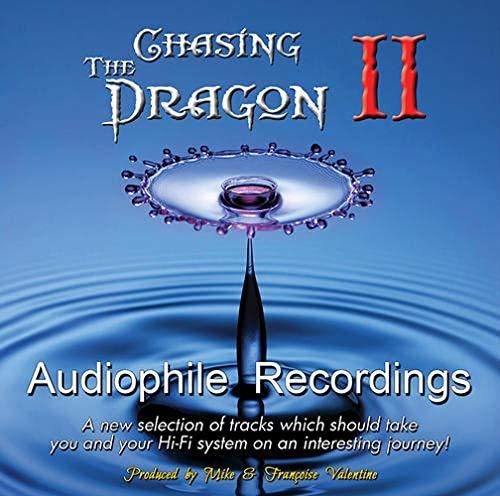
Various “Chasing the Dragon II”
Although different in style from Extended Dynamic Experience 4, this compilation also makes for a wonderful system test. The emphasis here is on recreating the space in which each track was recorded. In most cases, a simple pair of microphones was used for the recording, and each venue was unique.
We opened with the Syd Lawrence Orchestra performing Ted Heath’s ‘Hawaiian War Chant.’ It’s a wonderful song for setting a mood of early 1950s luxury listening in a fairly large room with a structured sound stage for the performers. The Focus towers again impressed with the ease of delivering this big band into one’s listening room with a wide stage that is also properly not deep (there are only two rows of performers of 10 performers per row).
Next up is the Darbourne Ensemble Choir performing ‘Nolo Mortem Peccatoris,’ which gave the big towers ample opportunity to show off their talents with both male and female vocals. Eight individual voices were perfectly placed in a semi-circle in a rather large cathedral, and the experience is almost eerie to one’s ears (as was a later track of a Church Organ pouring out Bach’s Toccata and Fugue in D at the Temple Church in London. This track gave this goosebump-resistant reviewer a healthy dose of said goosebumps. The sense was borderline a removal of the walls in our listening room combined with an immense wall of music coming at the listening position. NOT for the faint of heart!)
‘Drum Kit’ is just that: an incredibly well-recorded drum solo that will test both the dynamics and accuracy of one’s system. The Focus XDs had no problem hitting 110dB peaks at the listening position without a hint of distortion. I rarely listen to music at this level, and very few speakers can do this without some power-handling issues. From the kick drum to the snare, there was this feeling that one was in the studio with the drummer, which is what a top-shelf speaker should be able to do.
Space prevents exploring all 17 tracks on ‘Dragon II,’ but it was nothing less than a thrill to spend the hour with this superlative performance. After four discs, two with the standard cable setup that I used for the last two years, and two with the Clarus ensemble, it was getting quite clear that the Legacy Focus XD was a pair of $15,200 speakers that could be considered a true super speaker.

2009 “Star Trek”
The 2009 Star Trek movie completely changed the original timeline of the classic 1960s series that started it all. It’s a tremendous story and an even better audio treat. The movie starts with George Kirk (Captain James T. Kirk’s father) as captain of the USS Kelvin, a starship a full generation older than the USS Enterprise we all know and love.
The ship is under attack from a massive, unknown ship which is about the size of 1000 USS Kelvin’s combined. There is an abundance of sound occurring simultaneously. We have a full orchestra playing, the deep bass rumbling from the enemy ship, all the “beeps” and “boops” from the Kelvin’s bridge (those who have seen the original series will remember this), laser blasts, torpedo hits, etc…
The baby is born and is a boy that we know as James T. Kirk. Kirk tells his wife he won’t be there. She is devastated, and all the special effects sounds go silent, leaving just the string section of the orchestra playing while we pan back and forth to Daddy Kirk steering his ship into the enemy ship against Mommy Kirk crying with the baby in her arms. It’s a very emotional scene that ends with the effects turning back on so we can hear Dad telling Mom he loves her as his ship is destroyed while causing enough damage to the enemy ship that most of the crew is saved along with Mom and Baby.
This entire movie is filled with sonic wonders from additional orchestral movements to battle scenes to echo effects in caves on an ice planet where, 30 years after the opening scene, our Jim Kirk is marooned with Spock. The Legacy towers not only got through all this without flinching, but they also exceeded every speaker I have ever listened to with Star Trek (2009). The climax of the movie has Kirk (Jim) on the enemy ship with Spock finishing a gambit in which he manages to get the enemy to destroy his own ship with its futuristic arsenal all while the Enterprise is also firing everything it has at the enemy ship. The entire scene is awe-inspiring in terms of percussive bass, deep bass, surround effects, and the score soaring along with the effects team. The Focus XDs bested every speaker I have ever auditioned with this movie, including some well-thought-of 7.2 channel systems. If you wonder if ‘stereo’ can be great for movies: it can.
Craig’s home is a modest 4-hour drive from my house, and I visited him recently to pick up some equipment he is reviewing for bench testing.
I spent the better part of an afternoon and evening with Craig listening to the Legacy Focus XDs. He graciously let me monopolize this time, playing all kinds of music tracks that I had preloaded onto a USB thumb drive which I’d brought along.
Before I go into any details about the sound, the speakers themselves were just these visually stunning Rosewood totems holding court in his home’s basement. For me, the Focus has always been “that” speaker from Legacy which has the perfect shape, dimensions, and overall aesthetic that appealed to my tastes. The quality of the satin Rosewood finish that I was examining here was completely “off the hook” and stands with some of the finest finishes that I’ve seen on a loudspeaker, ever. It would be the one I would pick, hands-down if I were ordering a pair.
Sitting down and listening to them play was an impactful and revealing experience. The soundstage these speakers put out was positively massive and intricately detailed.
The entire mid-woofer and dual AMT midrange/tweeter section rendered both vocals and instruments with an immediacy and transparency that was hard to believe from a speaker with such a big footprint. Thankfully, the Legacy’s sound signature never crossed over into ruthlessness and remained enjoyable to listen to for my entire visit. The solo piano from my Ahmad Jamal “Ballades” test track sounded particularly outstanding on the Focus XD, rich and crystalline in the upper registers while deep and solid in the lower notes. The Legacy did as good a job as I have ever heard at making Jamal’s piano sound very much “alive” and right in front of me.
The bass produced by the active dual 12-inch woofers felt powerful enough to scramble your insides in that basement listening space. It was tight, visceral, and unrelenting. At times and depending on the track I felt, while fun, the bass level might have been a little too much for that room. This is saying something as I’ve heard all manner of speakers and subwoofers in Craig’s basement over the years, and while I loved the powerful bass for most tracks, on select others I came away thinking the bass was a bit too much on certain tracks. The way Craig had the speakers configured with the Marantz AV10 pre-pro allowed for adjustments to the bass levels. I didn’t ask him to turn it down as the room pressurization was too enjoyable. If one is planning to bi-amp the Focus XD while using a standard stereo preamp and some Y-cables, then getting the optional Nobsound external attenuation box (mentioned in the Design section) might be a good idea. The Nobsound unit will help fine-tune the bass output for your room since there is no independent adjustment on the speakers. This becomes moot when using an external preamp-processor like Legacy’s Wavelet 2 (or a high-end pre-amp/processor with separate subwoofer XLR outputs). Craig will be doing a follow-up review of the Focus XD with the Wavelet 2 pre-amp.
In my opinion, the Focus XD loudspeakers pretty much have it all, in terms of beauty, sound quality, and ultimate flexibility. They easily compete with far more dearly priced speakers from all over the world, and in that context reward the discerning listener with excellent value to boot.
I ran three different measurements on the Focus XD pair. All three were taken from my primary listening position with no external eq or processing added. Here are the results:

1. 100-20,000Hz: The response was +/- 3 dB at the listening position, which is a little over 3.5 meters from the speakers. The volume level was set at 95dB, which is quite loud, especially at this distance. This demonstrates remarkable linearity – the most we have ever measured from any pair of loudspeakers.
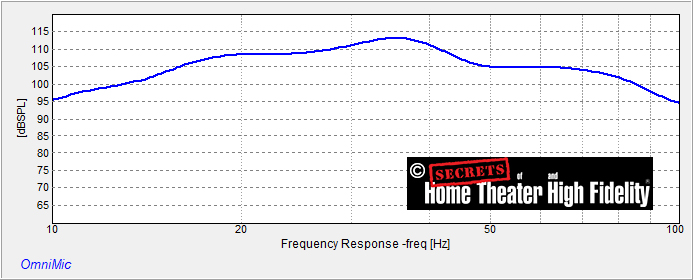
2. 100-10Hz: Our listening room tends to dial in quite the house curve with any subwoofer that can deliver deep bass. The subwoofer section of the Legacy Focus XDs measured as the deepest, most powerful bass we have recorded yet, with an extension that remained solid to 10Hz. This is lower than any subwoofer we have tested in our room, including a pair of subwoofers which sell for the same $15,000 that the Legacy speakers get for the entire system.

3. The THD for the speakers, again measured at about 3.5 meters and at 95dB (which would translate to over 110dB at one foot) was exceptional. We have never, even with the best subwoofer, started the THD at 10Hz. The results are as follows:
- 10Hz: 4.02%
- 15Hz: 1.57 %
- 20Hz: 0.96%
- 5Hz: 0.52%
- 32Hz: 0.31 %
- 40Hz: 0.27 %
- 50Hz-7,000Hz: less than 0.25 %
- 7,000Hz-10,000Hz: less than 0.2%
This measured performance agrees with our ears: the Legacy Focus XD loudspeaker system is a true super speaker that one would usually expect to pay north of $50,000 per pair to get. It delivers linearity from below 15Hz up to (and beyond) 20,000Hz. Its measured performance is nothing short of state-of-the-art and is a testament to well-thought-out engineering.
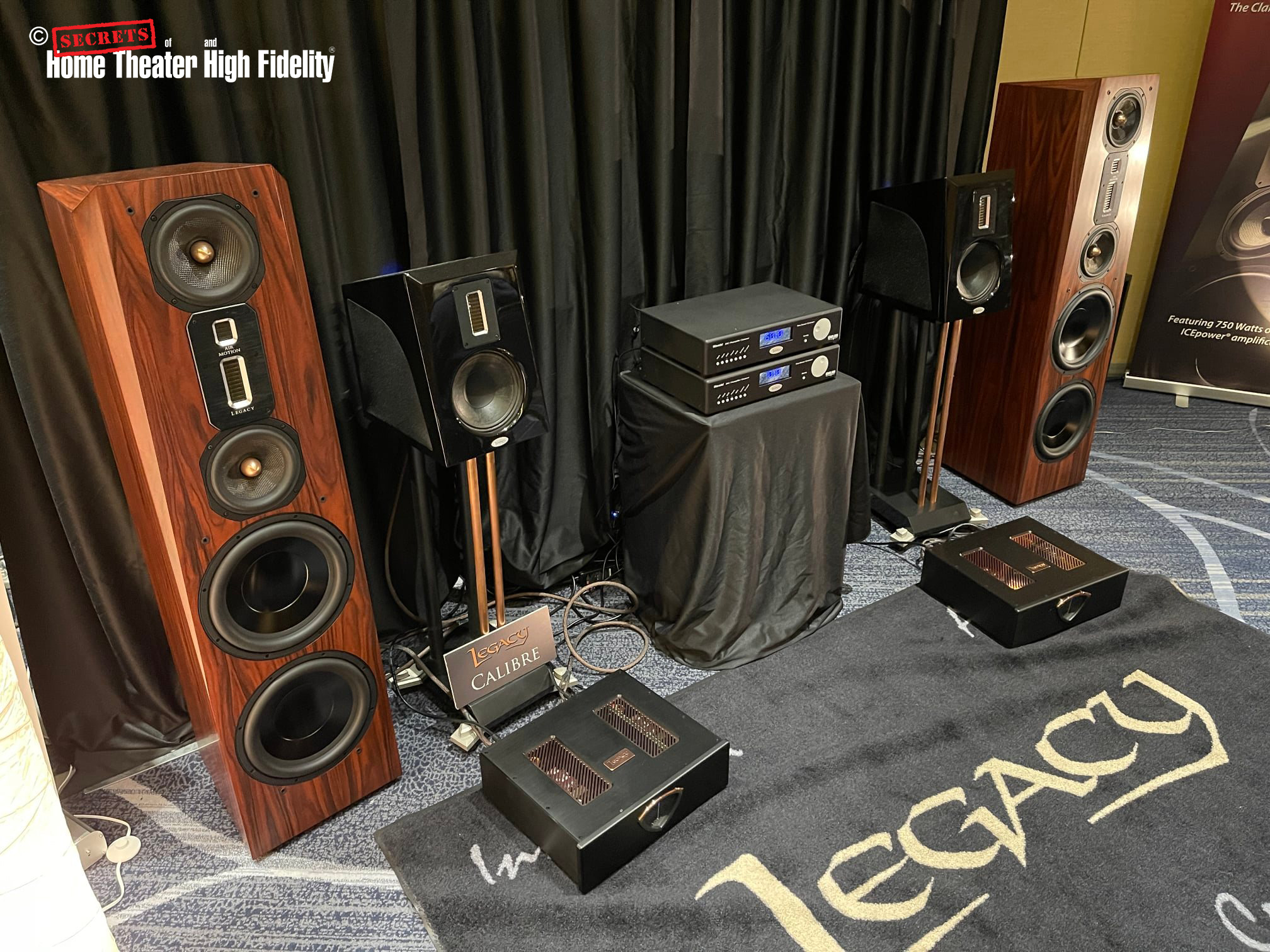
The Legacy Focus XD can truly be considered as an end-game speaker for many listeners. The fact that they are not stratospherically priced in relation to the performance they provide makes them a screaming value to boot! Highly recommended!
- Beautiful fit and finish.
- Powerful and effortless sound across the entire audible bandwidth.
- A genuine value when compared to other high-end speakers.
- Nothing of consequence.
What should we expect to pay for state-of-the-art speakers? How many speakers on the market can deliver a 10Hz bass floor along with distortion levels at high volume that, from 20Hz and up, would be respectable for a power amp, and rarely found in a speaker system?
It is against that line of thinking that this reviewer is considering the Legacy Focus XD. Over the last few years, I have been looking at a variety of ultra-high-end speakers from companies like Magico and Wilson Audio. The speakers in question are all over $50,000 per pair. The auditioning was done in several high-end audio salons with the cost of amplification/source/cables/power conditioners exceeding $100,000.
I was hoping that the Focus XD would afford an audiophile a healthy slice of this rarified high-end sound for about a quarter the price of entry of these other speakers. What I experienced was a pair of speakers that brought a similar type of full-range, effortless sound into my room with a palpable sense of reality that I was certain would cost a whole lot more.
I would be remiss in leaving out that the Clarus Cables, Power Cords, and Power Conditioners took this wonderful system to an even higher level. I would also be leaving out important information if I didn’t point out that the Clarus system used here (about $20,000 in total for everything) was quite a bit less expensive than the cables/conditioner systems I have auditioned elsewhere. That $20,000 is for two power conditioners, one set of speaker cables, 5 sets of XLR cables, and 6 power cables. A full review will be forthcoming later this year.
The Legacy Focus XD loudspeakers are an astonishingly good product. They will deliver on any type of music you want to throw at them, from a string quartet to anthem rock. They are quite efficient, beautifully finished, and wonderfully transparent without being harsh at any time or SPL level.
They are also a speaker which can grow with the purchaser. For the purposes of this review, all listening was done with the McIntosh MC303 amplifier. However, with the flip of two switches on the back of each speaker, one could easily run the Focus XD full range with the built-in 750-watt amplifier. Many studios configure them this way for monitoring purposes, and they are outstanding performers. If you have a pre-amp with XLR outputs, you could start a system with the Focus XDs alone and add a power amp later for the 7-inch mid-woofers and air motion tweeters.
Over the last 3 years, I have added the Harbeth SHL5 Plus XD / MJ Acoustics Kensington subwoofer, Sonus faber Maxima Amitor / Gravis VI subwoofers, and the Vaughan Line Array Major/MJ Acoustics Kensington subwoofers to my personal reference speaker systems. All are outstanding performers within their limits.
The Focus XD has taken the position within my personal reference speakers, as my (until something knocks them off the top) ultimate reference loudspeaker system. They best the above-mentioned reference speakers at every level. They play deeper, with less distortion, and with a sense of ease that the other speakers cannot quite accomplish and do so in an elegant package. They are more than highly recommended: they are the reason one might ask ‘why pay more?’
Please stay tuned for part II of this review with the Legacy Wavelet II pre-amp and room correction software component replacing the Michi and Marantz units.
Thank you for the very thorough examination of the Legacy Focus XD. The speaker system has been continuously refined over three decades, as technology would allow. The fundamentals of the design provide a smoothly increasing radiating area with growing wavelength, and a radiation pattern that reduces floor-bounce coloration while providing unrestricted dynamic range.
The acceleration factors of the drivers are far higher than the norm, which facilitates effortless articulation even at high SPLs.
Bill Dudleston
Legacy Audio


